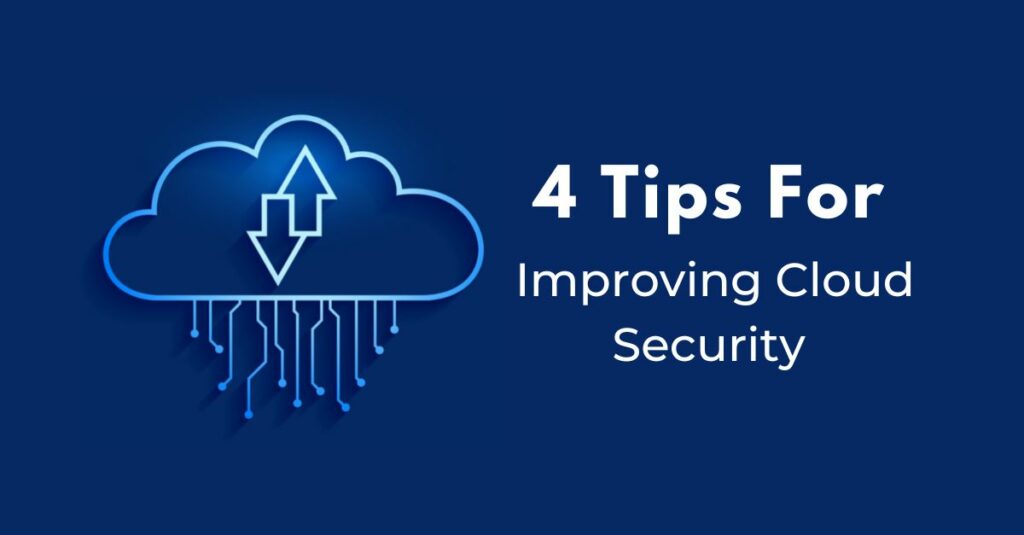4 Tips for improving cloud security
Cloud security protects critical applications and data from attacks and unauthorized access. It is especially important since at least 50% of data worldwide is stored and processed in the cloud, and 60% of enterprises have implemented multi-cloud infrastructure. The increased reliance on cloud solutions to manage data, enable remote working, scale business operations, and provides instant network resources, has provided attackers with numerous incentives for targeting cloud services. According to a 2022 security report, 27% of organizations suffered a cloud security breach, with misconfigurations and poor data security practices contributing to 23% and 15% of the attacks, respectively. Here are the top four practices for enhancing cloud security.
1. Strengthen the security configuration
Many companies are turning to multi-cloud infrastructure to drive business operations. A recent survey found that more than 30% have at least three cloud computing providers and the increasing complexities introduce security concerns due to misconfigurations. Misconfiguration is one of the largest cloud computing security threats, but strengthening cloud security configuration can improve cloud security.
Firstly, adopt effective user management procedures. User management is the ability to manage devices, networks, systems, and users that can access and use cloud services. It is a core part of cloud IAM (Identity and Access Management), which involves defining the users who can access cloud resources. Users and devices should only be provided with the minimum level of access required in work, so as to protect cloud data and applications from unauthorized access and misuse.
Verify the access permissions of cloud data, files, and assets. Performing security audits can identify users with unnecessary permissions that heighten security risks and assets exposed to public access. For example, in 2021, a cyber-analytics firm exposed five billion personal records after allowing public access to a database without password or encryption protection. Verifying the access permissions can prevent such incidents from occurring.
Also, enable multi-factor authentication MFA for all cloud accounts since 61% of breaches involve compromised credentials. Additionally, it would be a good idea if you make use of a whitelist of devices, users, and regions that can access your cloud environment to reduce the possibility of an attack. Finally, it is important to check if cloud applications installed by users into their cloud accounts are not being exploited by third parties to attack the organisation.
2. Monitor your user logs
Most cloud providers provide audit logs for user activities. The audit logs record activities performed in the cloud environment. These include configuration changes, provision of new cloud resources, and the user accounts involved in the activities. Monitoring these user activity logs is key to early detection of cloud breaches. For example, continuous cloud monitoring can identify suspicious data access, such as accessing data at odd business hours and unusual download of data. User activity logs can reveal suspicious logins. For example, multiple login attempts from different devices spread across different locations may be due to compromised credentials. Monitoring of privileged user activities can identify suspicious behaviors which may result in a data breach, such as sharing cloud resources with external parties and the sudden creation of mailbox forwarding rules.
3. Encrypt your cloud data
A 2021 research drawing at least 2,600 security and IT experts found that a surprising 83% of businesses do not encrypt half of their crucial cloud data. At the same time, 24% of organizations store all their data and workloads in the cloud. Cloud data encryption transforms data from a readable text format to a scrambled format that can’t be read without the decryption key.
Enabling encryption by default in the cloud environment encrypts data at rest and in transit, thus protecting it from malicious actions even if it falls into the wrong hands.
For additional protection, you can consider separately encrypting data before storing or transferring it to the cloud, so as to prevent access or modification by unauthorized users (however this may or may not be feasible, depending on how the cloud data is to be used).
4. Provide anti-Phishing training for employees regularly
51% of companies blame phishing for compromised cloud credentials. Phishers trick users into clicking malicious links that lead to spoofed websites and reveal login credentials. For example, an attacker may pose as an IT security staff in an organization and target employees with phishing emails requiring them to address some issues with their cloud accounts. Untrained employees often fall for this trap and reveal their login credentials.
Anti-phishing training is an essential practice for strengthening cloud security. Anti-phishing education trains employees on how to identify phishing emails. It also trains on how to report such messages and how they can report to security staff for further investigation. By understanding how phishing works, employees can avoid falling victim, which leads to enhanced cloud computing security.
Summary
Cloud security incidents will continue increasing as more users adopt cloud services. Strengthening security configurations should include adopting effective user management practices such as IAM. Verifying access permissions helps to identify users with excessive permissions and to identify publicly exposed data. Enabling MFA can protect your cloud environment from unauthorized access via compromised credentials. Continuous monitoring of cloud user logs is key for early detection of cloud beaches. Monitor user logs to identify suspicious data access, suspicious login patterns, and anomalous behaviors that can result in a serious data breach. It helps to encrypt cloud data at rest and in transit to protect against unauthorized modification and access. Lastly, it is a good idea to train employees to identify and respond to phishing attacks.
How can InsiderSecurity help?
InsiderSecurity CSM (Cloud Security Monitor) provides automated monitoring of cloud user logs. It is a simple-to-use SaaS for enterprises to monitor their data security in Microsoft 365.
With its award-winning automated cybersecurity analytics and machine-learning, InsiderSecurity CSM makes sense of the high volume of Microsoft 365 activity events, so that you do not have to. It provides an easy way to monitor your Microsoft 365 data security. CSM discovers insider threats, compromised accounts, and suspicious data access. It can also discover documents shared with the public by accident.
Contact us now and try a demo!
4 Tips for improving cloud security Read More »






